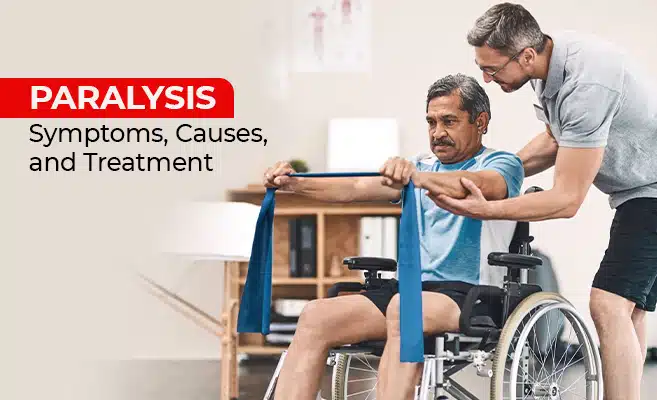Body paralysis, commonly referred to as paralysis, is the lack of voluntary movement and muscle function in one or more body parts. There are numerous potential causes, such as:
Stroke: When blood flow to a portion of the brain is disturbed, brain cells are damaged and function is lost. If the afflicted area of the brain regulates motor functions, paralysis may follow.
Paralysis can occur below the site of a spinal cord damage, which is frequently caused by trauma or accidents. The location and extent of the injury determine the degree of paralysis.
Neurological Disorders: By impairing the neurological system’s capacity to send impulses to the muscles, diseases including multiple sclerosis, Guillain-Barre syndrome, and amyotrophic lateral sclerosis (ALS) can render a person paralyzed.
Trauma: Physical wounds can harm nerves or the spinal cord, resulting in paralysis. These wounds can be caused by vehicle accidents, slips and falls, or sports injuries.
Tumors: Tumors that are developing in or close to the brain or spinal cord may irritate these structures and cause paralysis.
Paralysis can result from various illnesses, including polio and some viral or bacterial infections that impact the neurological system.
Autoimmune Reactions: A few autoimmune illnesses, such as transverse myelitis, can cause the spinal cord to be attacked by the body’s immune system, resulting in paralysis.
Genetic abnormalities: Some genetic abnormalities can impair how muscles work and cause paralysis. For instance, a set of hereditary illnesses known as muscular dystrophy cause gradual muscle atrophy and function loss.
Toxins: When nerves are exposed to specific toxins or chemicals, paralysis can result.
here are some additional details about body paralysis:
Hemiplegia and hemiparesis: Hemiplegia is the medical term for paralysis on one side of the body, which is frequently brought on by a stroke or other brain injury that affects one hemisphere. A less severe kind of weakness on one side of the body is called hemiparesis.
Quadriplegia and paraplegia: Quadriplegia, commonly referred to as tetraplegia, is characterized by the paralysis of the torso and all four limbs. Legs are often affected by paraplegia, which affects the lower half of the body.
Spastic paralysis differs from flaccid paralysis in that flaccid paralysis results in limp and weak muscles due to a loss of muscular tone and reflexes. Increased muscular tone and heightened reflexes caused by spastic paralysis result in stiff and tight muscles.
Central paralysis and Peripheral paralysis: Damage to the brain or spinal cord can result in central paralysis, which is different from peripheral paralysis. Damage to the peripheral nerves that link the central nervous system to the rest of the body causes peripheral paralysis.
Functional paralysis: On occasion, people may have functional paralysis, in which there is no actual harm done to the muscles or nerves but instead a lack of motor function brought on by psychological or emotional issues. In situations of conversion disorder or psychogenic paralysis, this is frequently observed.
Treatment and rehabilitation options include physical therapy, occupational therapy, speech therapy, and rehabilitation programmed, depending on the reason and degree of paralysis. Adaptive equipment, communication tools, and mobility assistance are a few examples of assistive technologies that can significantly enhance quality of life.
Research in regenerative medicine, such as nerve regeneration methods and stem cell therapy, shows hope for regaining lost function in paralysis cases. While still in the experimental stage, these strategies present viable paths for treatment in the future.
Challenges and coping: The effects of paralysis can be severe on a person’s physical, mental, and social well-being. People who have paralysis frequently struggle with issues like mobility, independence, self-worth, mental health, and interpersonal connections. Counselling, support groups, and coping mechanisms are crucial to handling these difficulties.
Prevention: By altering one’s lifestyle, taking steps to prevent injuries, and receiving prompt medical attention, many causes of paralysis, such as stroke and spinal cord injuries, can be avoided or at least lessened.
Developments in Assistive Technology: New technologies are constantly being created to improve the mobility and functionality of people with paralysis. Examples include brain-computer interfaces (BCIs), exoskeletons, and robotic prostheses.
Advocacy and Education: A number of organizations and advocacy groups are committed to educating people about paralysis, advancing research, and enhancing the lives of those who are afflicted by it.
It’s crucial to remember that every instance of paralysis is different, and that specific circumstances can have a significant impact on treatment and prognosis. The future of paralysis treatments and quality of life for those who suffer from the condition is bright because to developments in medical research and technology.





























